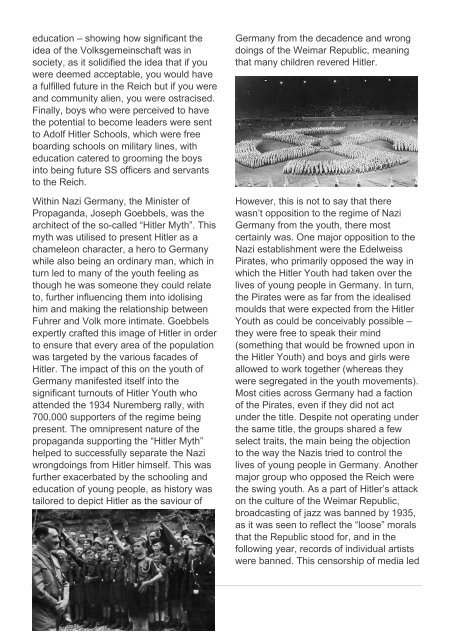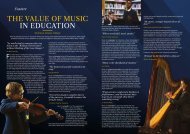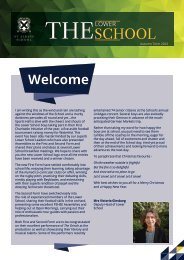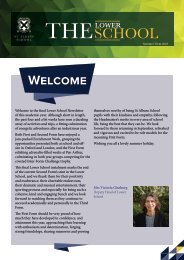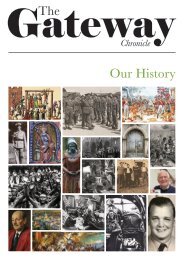Gateway Chronicle 2022
Create successful ePaper yourself
Turn your PDF publications into a flip-book with our unique Google optimized e-Paper software.
education – showing how significant the<br />
idea of the Volksgemeinschaft was in<br />
society, as it solidified the idea that if you<br />
were deemed acceptable, you would have<br />
a fulfilled future in the Reich but if you were<br />
and community alien, you were ostracised.<br />
Finally, boys who were perceived to have<br />
the potential to become leaders were sent<br />
to Adolf Hitler Schools, which were free<br />
boarding schools on military lines, with<br />
education catered to grooming the boys<br />
into being future SS officers and servants<br />
to the Reich.<br />
Within Nazi Germany, the Minister of<br />
Propaganda, Joseph Goebbels, was the<br />
architect of the so-called “Hitler Myth”. This<br />
myth was utilised to present Hitler as a<br />
chameleon character, a hero to Germany<br />
while also being an ordinary man, which in<br />
turn led to many of the youth feeling as<br />
though he was someone they could relate<br />
to, further influencing them into idolising<br />
him and making the relationship between<br />
Fuhrer and Volk more intimate. Goebbels<br />
expertly crafted this image of Hitler in order<br />
to ensure that every area of the population<br />
was targeted by the various facades of<br />
Hitler. The impact of this on the youth of<br />
Germany manifested itself into the<br />
significant turnouts of Hitler Youth who<br />
attended the 1934 Nuremberg rally, with<br />
700,000 supporters of the regime being<br />
present. The omnipresent nature of the<br />
propaganda supporting the “Hitler Myth”<br />
helped to successfully separate the Nazi<br />
wrongdoings from Hitler himself. This was<br />
further exacerbated by the schooling and<br />
education of young people, as history was<br />
tailored to depict Hitler as the saviour of<br />
Germany from the decadence and wrong<br />
doings of the Weimar Republic, meaning<br />
that many children revered Hitler.<br />
However, this is not to say that there<br />
wasn’t opposition to the regime of Nazi<br />
Germany from the youth, there most<br />
certainly was. One major opposition to the<br />
Nazi establishment were the Edelweiss<br />
Pirates, who primarily opposed the way in<br />
which the Hitler Youth had taken over the<br />
lives of young people in Germany. In turn,<br />
the Pirates were as far from the idealised<br />
moulds that were expected from the Hitler<br />
Youth as could be conceivably possible –<br />
they were free to speak their mind<br />
(something that would be frowned upon in<br />
the Hitler Youth) and boys and girls were<br />
allowed to work together (whereas they<br />
were segregated in the youth movements).<br />
Most cities across Germany had a faction<br />
of the Pirates, even if they did not act<br />
under the title. Despite not operating under<br />
the same title, the groups shared a few<br />
select traits, the main being the objection<br />
to the way the Nazis tried to control the<br />
lives of young people in Germany. Another<br />
major group who opposed the Reich were<br />
the swing youth. As a part of Hitler’s attack<br />
on the culture of the Weimar Republic,<br />
broadcasting of jazz was banned by 1935,<br />
as it was seen to reflect the “loose” morals<br />
that the Republic stood for, and in the<br />
following year, records of individual artists<br />
were banned. This censorship of media led<br />
48 | G ateway <strong>Chronicle</strong>


